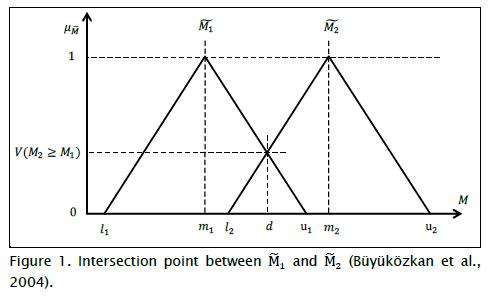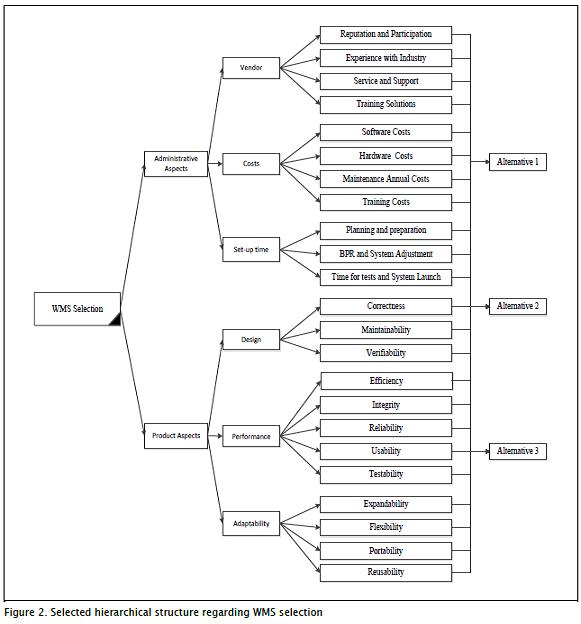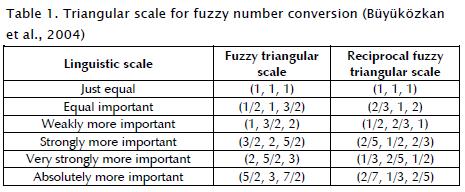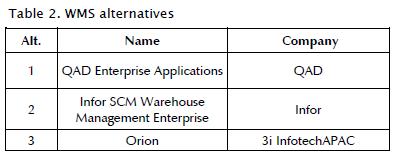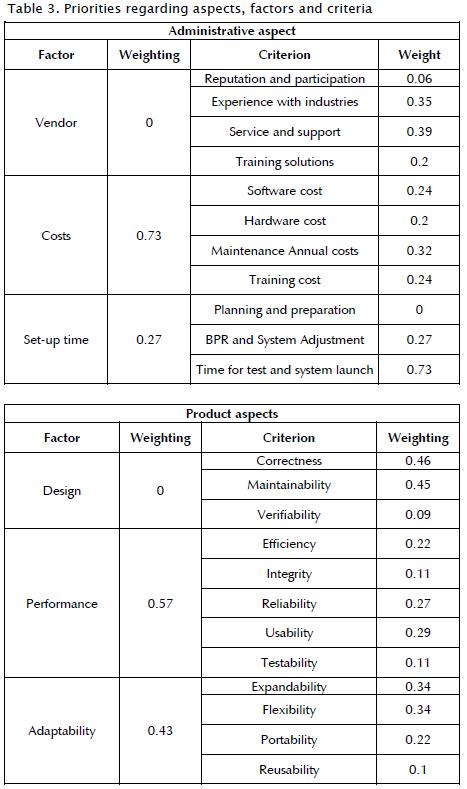Services on Demand
Journal
Article
Indicators
-
 Cited by SciELO
Cited by SciELO -
 Access statistics
Access statistics
Related links
-
 Cited by Google
Cited by Google -
 Similars in
SciELO
Similars in
SciELO -
 Similars in Google
Similars in Google
Share
Ingeniería e Investigación
Print version ISSN 0120-5609
Ing. Investig. vol.32 no.1 Bogotá Jan./Apr. 2012
Applying fuzzy extended analytical hierarchy (FEAHP) for selecting logistics software
Aplicación del proceso de análisis jerárquico extendido con lógica difusa para la selección de software para logística
Julián Andrés Zapata Cortés1, Martín Darío Arango Serna2, Wilson Adarme Jaimes3
1 MSc in Management Engineering. Full time professor, Institución Universitaria ESUMER. jzapatac@esumer.edu.co.
2 PhD in Industrial Engineering. Full time professor Universidad Nacional de Colombia â Medellín. E-mail: mdarango@unal.edu.co.
2 PhD in Engineering. Full time professor. Universidad Nacional de Colombia â Bogotá. E-mail: wadarmej@unal.edu.co.
Received: November 5th 2010; Accepted: February 27th 2012
RESUMEN
Este artículo presenta la aplicación del proceso de análisis jerárquico - Método AHP extendido con lógica difusa en la selección de una herramienta de software para logítica tipo WMS (Warehouse Management System) en un astillero Colombiano. El método AHP ha sido utilizado ampliamente para resolver problemas de análisis de decisión en donde es necesario involucrar un alto número de factores y variables tanto cualitativas como cuantitativas, sin embargo, la mayor critica a este método es que el mismo no permite la inclusión de juicios de valor en una escala continua, sino discreta, lo cual se puede corregir al integrar la lógica difusa. Este problema encuentra solución con la extensión del método AHP con lógica difusa, desarrollado por Chang en 1996. Adaptado para un contexto especifico como el de un Astillero en Colombia.
Palabras clave: Software, toma de decisiones, método AHP, Lógica difusa.
ABSTRACT
This paper shows fuzzy extended analytical hierarchy (FEAHP) applied to a warehouse management system (WMS) in a Colombian shipyard regarding selecting pertinent logistics software. The FEAHP method has been widely used for resolving decision-making problems where many quantitative and qualitative factors and variables are required. However the most important criticism of this method concerns the impossibility of including value judgments not on a continuous scale but rather on a discrete one which can be solved by fuzzy logic. This problem was resolved by using the fuzzy logic extension of the AHP method proposed by Chang in 1996 which was adapted for a specific context regarding a Colombian shipyard.
Keywords: Software, decision-making, AHP method, fuzzy logic.
Introduction
Selecting information technology and communication software becomes an analysis of multi-criteria decisions where decision-making group priorities and judgments must be identified, depending on their experience, knowledge and preferences and thus improving decision-making (Maggie et al., 2001). People become linked to biological and psychological aspects in decision-making, such as perception and prejudice; these, in turn, become affected and influenced by team members.
Using analytical tools leads to reducing such effects; based on mathematical programming, these tools seek to reduce the divergence of alternatives created by the human mind. However, avoiding human perception can also be negative since factors such as experience and knowledge are the key to decision-making success or failure (Lin and Hsu, 2007). The challenge of analytical tools in decision-making is to combine the benefits of reducing the human condition of making mistakes when making assumptions about alternatives and taking personal factors like experience into account to improve selection.
This research focused on the applying fuzzy extended analytic hierarchy process (FEAHP) for selecting a warehouse management system (WMS) information system in a shipyard for which no past work in Colombia was found, making this study innovative in such industry.
Analytical hierarchy process (AHP) method
Analytic hierarchy process (AHP) was designed to support decision-making when both qualitative and quantitative variables must be considered (Hurtado and Bruno, 2005 and Saaty, 2005). The method was first introduced by Saaty in 1976 and it has gradually evolved until the present day, finding diverse applications in fields such as energy investment, marketing, project evaluation and technology selection (Saaty, 2005). This method is theoretical concerning relative measurement on absolute scales of tangible and intangible criteria judgments based on experts' knowledge and experience and on the measurements and statistics needed for decision-making (Hurtado and Bruno, 2005).
Fuzzy logic applied to the AHP method
AHP requires that comparisons and considerations about the criteria and alternatives are represented in a precise number, thus developing a preference matrix in which the method is based on selecting the best alternative (Saaty, 2005). However, as Büyüközkan et al., (2004) have stated that, ''those responsible for decision-making usually feel better presenting their judgments as a range, instead of giving a precise and fixed value. This is because he, she or they are unable to explain their preferences, given the diffuse nature of comparison'' (Büyüközkan et al., 2004).
Buckley (1985) incorporated a fuzzy matrix into the AHP method to involve this human condition so that vagueness in the response of people involved in decision-making can become integrated, getting closer to human reality and providing decision-making analysis with more validity (Huang and Wu, 2005).
Applying fuzzy set theory to the AHP method is known as fuzzy analytical hierarchical process (FAHP) and was defined by Huang and Wu (2005) in three steps. ''The first involves using triangular fuzzy numbers to transform the ideas of experts into a positive reciprocal matrix. Second, a geometric mean method that weighs the fuzzy values for each option, with the established hierarchical connection and finally, a membership function for each option that developed the ranking of priorities.''
The FAHP method is thus used in evaluating software and can be applied to analysis and decision-making. Huang and Wu have also stated (2005) that, ''with the help of the theory of fuzzy sets, some defects found in the traditional AHP method are solved, such as the application of limited scales for the explanation of the experts considerations, the correlation between attributes for decision-making, inaccuracy, ambiguity and uncertainty of experts to find the values of the comparisons.''
The FAHP method
The extended fuzzy analytical hierarchy process (EFAHP) was proposed by Chang (1992) and Chang (1996) and owes its name to the extension made to Saaty's method (Saaty, 1985). The model presented by Chang (1996) can be described as follows:  being a set of objects and
being a set of objects and  a set of objectives. According to the extended analysis method (Chang, 1992), extended analysis is developed for each object. m values of extended analysis can thus be obtained for each object, with the following notation:
a set of objectives. According to the extended analysis method (Chang, 1992), extended analysis is developed for each object. m values of extended analysis can thus be obtained for each object, with the following notation:
where all  are triangular fuzzy numbers. Büyüközkan et al., (2004) has summarized the key steps in the extended model proposed by Chang (1996) as:
are triangular fuzzy numbers. Büyüközkan et al., (2004) has summarized the key steps in the extended model proposed by Chang (1996) as:
Step 1. The value of i-th object of the extended analysis is defined as:
 can be obtained by adding fuzzy numbers to extended analysis values m for a particular matrix, so that:
can be obtained by adding fuzzy numbers to extended analysis values m for a particular matrix, so that:
Fuzzy numbers  must be added for obtaining
must be added for obtaining  , so that:
, so that:
The reverse matrix for equation (4), is calculated as:
Step 2. The degree of possibility that M2≥M1 is defined as:
where there is a pair (x, y) so that y ≥ x and  and
and  = 1. As
= 1. As  are convex fuzzy numbers, then:
are convex fuzzy numbers, then:
where d is the ordinate of the highest intersection point D located between µM1 and µM2 (Figure 1).  must be known to compare M1 and M2.
must be known to compare M1 and M2.
Step 3. The degree of possibility that a convex fuzzy number will be higher than k convex numbers is defined as:
Then, by assuming that
The weight vector is:
where  are n elements.
are n elements.
Step 4. The normalised weight vector is:
where W is not a fuzzy number but the set of weights for each matrix. The next section describes how to get all the elements to implement the EFAHP for selecting software.
Selecting software with FEAHP
Lin and Hsu (2007) have stated that selecting software tools is a complex process due to the large number of products available on the market, rapid change and many conflicting objectives. These authors have argued that many software tools can be selected using FEAHP. One of the main reasons for using FEAHP for selecting software is the complexity of the factors and criteria to be considered, addressing all these tools' features, ranging from technical to managerial factors. Qualitative and quantitative conditions must be involved in most cases.
Software selection criteria
According to Lien and Chan (2007), several factors must be considered when selecting information systems, grouped into two major categories: administrative and product aspects.
Administrative aspects. These include all the matters related to the characteristics relevant to managers regarding finance, operations and their relationships with their service providers. Lien and Chang (2007) and Liang and Lien (2007) have stated that the relevant criteria for selecting software would include vendor, set-up time and cost. Each aspect was thus associated with several attributes which were decisive for the proper selection of a software tool.
Aspects of the product. The bibliography for software selection concerns various international standards, particularly highlighting ISO 9126 and the quality assurance model proposed by the software quality assurance (SQA) group (Lien & Chang 2007; Büyüközkan et al., 2004).
After discussing both standards with the directors of the company in which the study was made, the SQA model was chosen for software selection, due to its practicality compared to the ISO model. It was easier to understand and use when applying information collecting instruments which could affect the quality and quantity of such instruments. This was based on experience in the company, where the use of extensive questionnaires, interviews and other ways of acquiring information have led to failure, due to confusion and workers' lack of motivation.
The SQA model is based on three criteria: the quality of design, performance and adaptability (Büyüközkan et al., 2004). Figure 2 shows the hierarchical structure, including all aspects, criteria and factors.
Fuzzy numbers and nomenclature
As mentioned above, human nature creates uncertainty and insecurity when assigning values for co mparison, this being the main problem associated with the AHP method. However, this can be solved by incorporating fuzzy logic (Arango et al., 2010 a; Arango et al., 2010 b; Büyüközkan et al., 2004, Huang and Wu, 2005; Chang, 1996). A language allowing fuzzy logic to be used when obtaining information for the people involved in decision-making analysis must be used and thus develop their judgments. This language was presented by Büyüközkan et al., (2004), consisting of a 9-level scale which can clarify experts' thoughts. This scale is represented by the set W= {ALI, VSLI, SLI, WLI, EI, WMI, SMI, VSMI, AMI}, where:
ALI: absolutely less important. VSLI: very strongly less important. SLI: strongly less important. WLI: weakly less important. EI: equally important. WMI: weakly more important. SMI: strongly more important. VSMI: very strongly more important. AMI: absolutely more important.
These opinions must be converted into the fuzzy numbers that represent them, allowing vagueness in the answers regarding the AHP model to be considered. Table 1 shows the conversion to fuzzy numbers used in the EFAHP (Büyüközkan et al., 2004, Chang and Cheng, 1994, Perez-Leon, 2007).
Methodology and Results
The following methodology was used for selecting the logistics software (WMS) in the company being studied. It seeks to ensure the smooth comparison and selection of WMS. The steps were supported by studies made by Lien & Chang (2007), Liang & Lien (2007) and Büyüközkan et al., (2004). These were:
• Studying the hierarchical structure, expert team selection, evaluation and selection of alternatives, collecting information about experts' preferences, creating the preferences matrix, weighting and selecting the WMS.
The problem's hierarchical structure was based on the analysis presented above, considering both administrative and product aspects which were accepted and approved by the directors of the company to structure hierarchical selection analysis using EFAHP. Nineteen types of WMS were analysed, supported by the Technology Evaluation Centers (TEC, 2010) virtual tool; three of these 19 alternatives were selected which fulfilled the requirements established by the managers and staff involved in such selection. Table 2 shows the alternatives analysed in this evaluation.
The evaluation team expressing its preferences regarding the criteria and alternatives was formed by three people: the managers of the logistics and supply chain, warehouse and office and information technology (IT) areas. These people's preferences were obtained by using a questionnaire which reported their preferences regarding the hierarchical structure and each of the three alternatives. The answers provided by the three evaluators about the hierarchical structure were calculated and weighted using fuzzy number arithmetic rules. Such weighting was used for constructing the preference matrices for each aspect, criterion and factor. Hierarchical weighting was obtained for the selected structure with these matrices and applying Chang's EFAHP method ( 995) (Table 3).
The alternatives regarding each criterion were compared by using a questionnaire where experts could record their preferences concerning such alternatives and criteria. Experts' opinions about comparing alternatives were analysed and weighted using fuzzy number arithmetical rules. Such weighting was used for constructing the preference matrices for the alternatives regarding each criterion. Weighting was calculated for the alternatives regarding hierarchical structure criteria with each of these matrices and by applying Chang's EFAHP method ( 995).
Table 4 presents the weighting values for the hierarchical structure and the alternatives so compared regarding the aspects, criteria and factors calculated above. Final preferences could be computed after weighting the alternatives regarding the hierarchical structure, which led to selecting the most suitable alternative for the company. Table 5 shows the calculations and final weighting for the alternatives considered in selecting the software.
Alternative 3 (WMS Orion) had the highest score and thus was the best alternative for the company's requirements; the WMS logistics software should thus have been selected.
Conclusions
A tool has been presented that involved people's subjectivity and uncertainty in decision-making; many comparisons are made and there are many alternatives and criteria to be considered in such situations.
The EFAHP method allowed handling the uncertainty associated with the judgement of experts involved in decision analysis and was able to include a large number of criteria, factors, attributes and evaluators because it was based on the AHP method. This is a tool for multi-objective and multi-criteria analysis; these two features mean that the EFAHP method can be used in selecting information tools associated with logistics, involving a large number of considerations and a group of experts, as shown in the present work.
The EFAHP method's ability to analyse complex decision problems involves a high degree of mathematical processing to compute the preferences and deal with fuzzy mathematical numbers. Evaluators are encouraged to acquire or develop software tools enabling them to do such operations automatically, but without forgetting the importance of knowing the basics of the EFAHP method which ensures the correct use of such software tools.
References
Arango, M.D; Serna, C.A. and Pérez, G. Fuzzy mathematical programming applied to the material requirements planning (MRP). Rev. Téc. Fac. Ing. Univ. Zulia. Vol:33, 2010a, fasc: 1. pp. 1 - 10 [ Links ]
Arango, M.D; Gaviria, H. and Vergara, C. Fuzzy modelling for aggregated production planning in uncertain environments. Revista DYNA, Año 77, Nro 162. 2010b, pp 397-411. [ Links ]
Buckley, J.J. Fuzzy hierarchical analysis. Fuzzy sets and systems, 17, 1985. 223-247. [ Links ]
Büyüközkan, G.; Kabraman, C. and Ruan, D. A fuzzy multi-criteria decision approach for software development strategy selection. Intern. Journal of General Systems, 33: 2, 2004. pp 259-280. [ Links ]
Chang, Da-Yong. Extend analysis and synthetic Decision, optimization techniques and Applications, World Scientific, Volume 1, Singapore. 1992. P. 352. [ Links ]
Chang, Da-Yong. Applications of the extent analysis method on fuzzy AHP. Eur. Journal of Oper. Research. 96, 1996. pp. 649-655. [ Links ]
Chang, P.-L. and Chen Y.-C. A fuzzy multi-criteria decision making method for technology transfer strategy selection in biotechnology, Fuzzy Sets and Systems, 63, 1994. 131-139. [ Links ]
Huang, L-C and Wu, R. Y-H. Applying fuzzy analytic hierarchy process in the managerial talent assessment model - an empirical study in Taiwan's semiconductor industry. Intern. Journal of Technology Management, Vol 30, No. ½. 2005. pp 105-130. [ Links ]
Hurtado, T. and Bruno, G. El Proceso de análisis jerárquico (AHP) como herramienta para la toma de decisiones en la selección de proveedores: aplicación en la selección del proveedor para la Empresa Gráfica Comercial MyE S.R.L. Thesis. Universidad Nacional Mayor de San Marcos. Facultad de Ciencias Matemáticas. EAP. Investigación Operativa. Lima, Perú. 2005 [ Links ]
International Standard Organization. Iso 9126. available in http://www.iso.org/iso/catalogue_detail.htm?csnumber=22891 Last visit: Jun. 2010. [ Links ]
Liang, Shing-Ko and Lien, Chi-Tai. Selecting the optimal ERP software by combining the ISO 9126 standard and fuzzy AHP approach. Contemporary Management Research, Vol.3, No.1. 2007, pp 23-44. [ Links ]
Lin, Hua-Yan and Hsu, Ping-Yu. Application of the Analytic Hierarchy Process on Data Warehouse System Selection Decisions for Small and Large Enterprise in Taiwan. International Journal of Computer, the Internet and Management. Vol 15. No. 3 (Sep. Dec., 2007) pp 73-93 [ Links ]
Lien, C-T and Chan, H-L. (2007). A Selection Model for ERP System by Applying Fuzzy AHP Approach. International Journal of The Computer, the Internet and Management Vol. 15.No.3 (Sep - Dec 2007) pp 58-72 [ Links ]
Maggie C.Y. Tama, V.M. and Tummalab, R. An application of the AHP in vendor selection of a telecommunications system. Omega, 29. 2001. pp.171-182 [ Links ]
Pérez, I. and León, B. Lógica difusa para principiantes. Publ. UCAB. Caracas. 2007. [ Links ]
Saaty, T. L. The analytic hierarchy and analytic network processes for the measurement of intangible criteria and for decision-making. Multicriteria decision analysis. State of the art surveys. Springer International Series. Springer Science + Business Media. Inc. 2005. [ Links ]
TEC- Technology evaluation Centers. The TEC Approach. Available in: http://www.technologyevaluation.com/tecapproach/ Last visit: Ago. 2010.-481.
[ Links ]



















